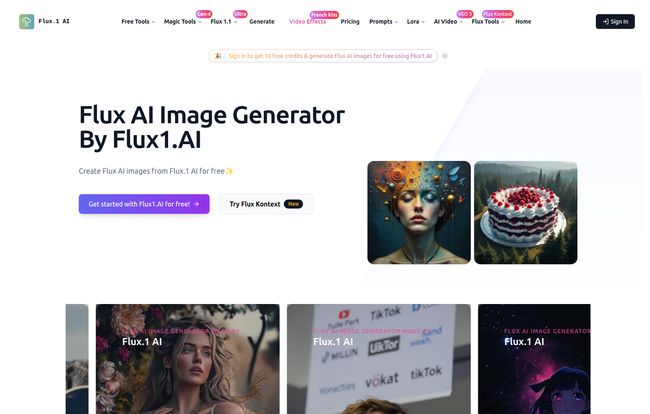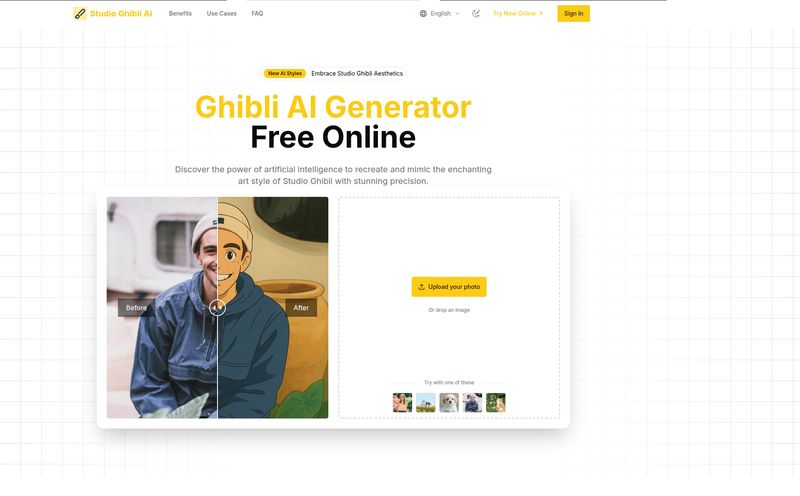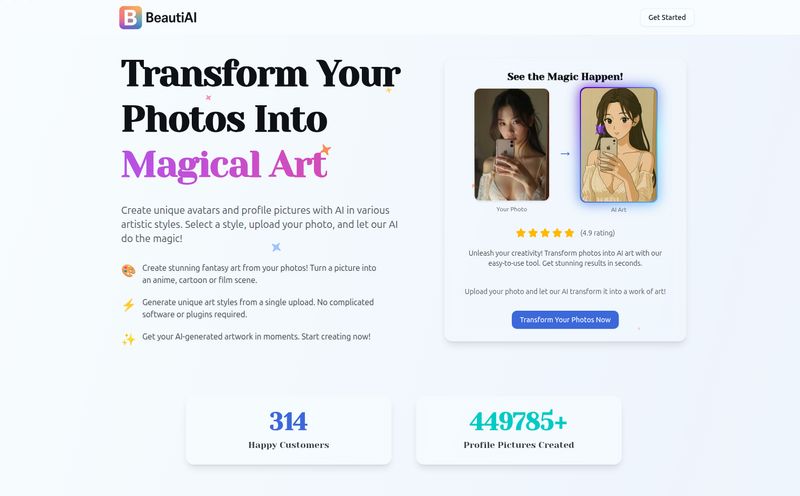In the world of SEO and content creation, we've all become pretty familiar with the AI image generation scene. It feels like every week there's a new 'Midjourney killer' or the 'next Stable Diffusion.' Most of the time, it's just hype. You try it, it’s a bit clunky, the images look like they were made in 2022, and you go back to what you know.
But every now and then, something pops up that makes you lean in a little closer. For me, that something is Flux.1.AI.
I stumbled upon it and, I've got to admit, my initial reaction was skeptical. Another one? Really? But the claims were bold: faster generation, insane quality, and—get this—open weights. That last one really got my attention. It’s a bit like a car company not just selling you a fast car but also giving you the full engine schematics. It’s a power move.
So, What's the Big Deal with Flux AI Anyway?
At its heart, Flux AI is a text-to-image model, just like the big names you already know. You type in a text prompt—'a photorealistic portrait of an astronaut drinking coffee on Mars'—and it spits out an image. Simple enough. But the magic, as always, is in the details.
The team behind Flux, Black-Mamba AI, built this thing on what they call a hybrid architecture. Without getting too bogged down in technobabble, they've basically combined a couple of different AI approaches (multimodal and parallel diffusion transformer blocks, for the nerds out there). Think of it like this: instead of having one worker slowly building your image brick by brick, you have a team of specialists working on different parts simultaneously. The result? Things get built a whole lot faster. And often, with better quality too.
The Need for Speed: Just How Fast Is It?
Let's be honest, waiting 60 seconds for a set of four images can feel like an eternity when you're in a creative flow. This is where Flux AI wants to make its mark. One of its versions, called FLUX 1.1 Schnell ('schnell' is German for 'fast,' by the way), is specifically designed for speed. And it lives up to the name.

Visit Flux 1.1 Pro
While testing, I found the generation to be noticeably quicker than many other platforms I use daily. This isn’t just a minor improvement; it changes the workflow. You can iterate on ideas rapidly, tweaking your prompt and getting near-instant feedback. It brings a sense of play back to the process, which can sometimes get lost when you're staring at a progress bar. It's a genuine game-changer for brainstorming and rapid prototyping of visuals for a blog post or social media campaign.
Okay, It's Fast. But Are the Images Any Good?
Speed is worthless if the output looks like a potato. I was worried Flux AI would be a one-trick pony—all speed, no substance. I was wrong. The image quality is genuinely impressive. It seems to have a knack for both photorealism and artistic styles.
I've seen it produce some incredibly detailed character portraits and complex scenes that hold their own against the top-tier generators. The ability to push outputs up to 2K resolution means you're getting images that are actually usable for more than just a small thumbnail. You could use these for hero images, presentation slides, or even some print materials. It handles nuance well, from the subtle reflections in a pair of glasses to the complex textures of a fantasy costume.
Open Weights: A Gift to the Tech-Savvy Creator
This is the part that excites the SEO-nerd and tinkerer in me. Flux AI offers open weights. This means that if you have the hardware, you can download the model and run it on your own machine. Why does this matter? Control.
You're no longer at the mercy of a web interface or a company's content filters (within reason, of course). Developers and studios can fine-tune the model on their own data. Imagine a brand training it to consistently produce images in its specific visual style, with its exact color palette. Or an artist creating a model that perfectly mimics their unique brush strokes. This is huge. It moves us away from a one-size-fits-all solution and toward truly personalized AI creation.
Of course, there's a catch: you need a beefy computer to do it. But the possibility is there, and for the professional community, that’s a massive plus.
The Different Flavors of Flux: Finding the Right One for You
Flux isn't a single product; it comes in a few different versions, which is smart. It allows them to cater to different users.
FLUX 1.1 Schnell: The Free and Fast Option
This is your entry point. It's free for non-commercial use and it's the speed-focused version. It's perfect for hobbyists, students, or anyone who just wants to play around and see what the fuss is about. The quality is still great, but it’s optimized for quick results.
FLUX 1.1 Pro & Dev: The Commercial Powerhouses
If you plan to use your AI-generated images for business—like on your blog, in ads, or for a client—you'll need to step up to the Pro or Dev versions. These are the top-tier models, likely offering the absolute best image quality and potentially more features. The pricing information isn't readily available on the site, which is a bit of a pet peeve of mine. You'll probably have to get in touch with them for details, but for any serious commercial work, this is the path to take.
Are There Any Downsides?
No tool is perfect, right? Here are a few things to keep in mind:
- The Commercial Paywall: The free version is great, but the moment you want to make money with your creations, you have to pay up. This is standard practice, but it's something to be aware of.
- Hardware for Local Use: The dream of running it locally is amazing, but it comes with the cost of some serious GPU power. It's not something you'll be doing on your five-year-old laptop.
- A Growing Pains: As a newer player, the community and documentation might not be as vast as something like Stable Diffusion's. Finding tutorials and support might require a little more digging.
My Final Take: Who Should Be Using Flux.1.AI?
After playing around with it for a while, I've got a pretty clear idea of who would love Flux AI.
Hobbyists and Creatives will adore the Schnell version. Its speed makes creating fun and frictionless. Developers and AI enthusiasts will be drawn to the open-weights aspect, offering a powerful new model to tinker with. And for professional marketers, bloggers, and content creators, the Pro version is a seriously compelling option, offering a potent mix of speed and quality that can genuinely speed up workflows. I can definitely see myself using this for featured images for my articles.
Is it going to dethrone Midjourney overnight? Probably not. But it doesn't have to. Flux.1.AI is carving out its own niche by focusing on speed and openness, and it's a very, very compelling niche at that. It feels less like another competitor and more like a different kind of tool for a different kind of job. And in my book, that's incredibly exciting.
Frequently Asked Questions about Flux AI
Is the Flux AI Image Generator really free to use?
Yes and no. The FLUX 1.1 Schnell version is free for personal, non-commercial projects. It's a great way to test the platform. However, if you want to use the images for any business purpose, you'll need to use the Pro or Dev versions, which are paid.
What makes Flux AI different from other AI art generators?
Its main differentiators are speed and its open nature. The hybrid architecture allows for much faster image generation than many competitors. Plus, the availability of open weights means advanced users can run and customize the model locally, which is a huge advantage over closed, proprietary systems.
How good is the image quality from Flux AI?
The quality is excellent, competing with top-tier models. It can produce highly detailed, photorealistic images and creative artistic styles at resolutions up to 2K, making them suitable for professional use cases.
Do I need a powerful computer to use Flux AI?
To use the web-based generator, you just need a standard web browser. However, if you want to take advantage of the open weights and run the model on your own machine, you will need a powerful computer with a modern, high-VRAM graphics card (GPU).
Is Flux AI capable of creating different styles of art?
Absolutely. Based on the examples and tests, it's very versatile. By crafting your text prompts carefully, you can guide it to produce everything from 'd&d concept art' and 'digital paintings' to 'realistic portrait photos'.
Conclusion
Flux.1.AI has entered a crowded field, but it's come prepared. It's not just another face in the crowd; it's a genuine contender that brings something new to the table with its incredible speed and commitment to open access. It's a refreshing change of pace, and a tool I'll be keeping a very close eye on. I highly recommend giving the Schnell version a spin—you might just be surprised at how fast your ideas can come to life.
Reference and Sources
- Flux.1.AI Official Website
- FLUX.1-schnell Model on Hugging Face
- Midjourney Official Website (for comparison)



